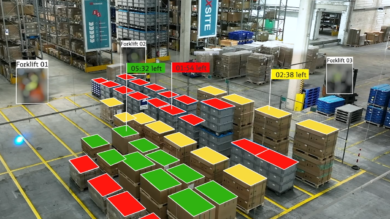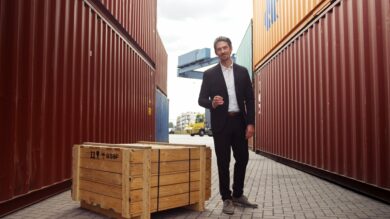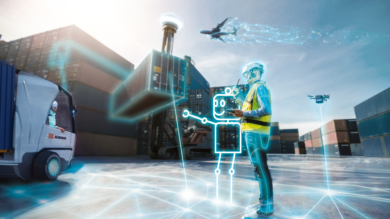The need for logistics has become ever more critical and has not played a more pertinent role in society than now. Erik Wirsing, Vice President of Global Innovation at DB Schenker, believes that the logistics industry is doing a fantastic job. Over the past couple of years, amid the pandemic challenges, the industry has leaned on technologies to support the ever-growing demand. Customers have become more demanding, requiring a frictionless experience, and as a result, putting more pressure on the supply chain. In an interview with Logistics Matters, Erik Wirsing shares upcoming trends in innovation and offers a sneak-peek into 2022 and the future, where innovation is driven in support of enabling sustainable ambitions.
“Through innovation, we’ve been able to fast-track digital solutions and new technologies during this challenging pandemic. Finding innovative technologies to deliver on our greater business ambitions is imperative in everything we do.”
Logistics Matters: “What top innovation trends can we see evolving in 2022 and beyond?”
#1: Electromobility
Erik Wirsing: “In the following years, many new technologies under the umbrella of sustainability will evolve and become more established. We see much research and development going into revolutionizing inner-city logistics and last-mile delivery. Online shopping is booming. E-commerce is booming. We are all getting more comfortable at home, and nobody’s really moving, which places extra pressure on the logistics industry. Therefore, electromobility will play a fundamental role as a sustainable technology, especially with the increase in deliveries and returns. A couple of examples is the first heavy lifted cargo drone test flight in late 2021 to fly cargo with an electric vehicle into the urban environment – drones will see further development. The penultimate mile is simultaneously becoming important. Here pipes might be used to transport pallet deliveries underground to micro hubs in the city and, after that, use electric cargo bikes for inner-city logistics.”
#2: Hydrogen Technology
Erik Wirsing: “Moreover, for long-distance, another topic to consider is hydrogen trucks. This would be fantastic, but more research is required to realize this fully. Nevertheless, some regulations and setups were implemented for hydrogen trucks last year. The first countries like Japan are investing more into hydrogen than electric mobility, and even in Europe. Much funding is available for hydrogen, but it’s more a chicken and egg situation as it’s good to invest in hydrogen trucks, but not when there is no infrastructure in place for this yet. Nevertheless, I’m sure these technologies are coming; it’s just a matter of time. And who would have thought that zeppelins could make a comeback? As unbelievable as it sounds, scientists are looking to bring back these historical airships believed to move cargo more efficiently and produce far less pollution. This would be my absolute dream to see!”
#3: Additive manufacturing
Erik Wirsing: “Additive manufacturing and 3D printing is an innovation advancing at a rapid pace. When supply chains completely crashed during corona – 3D printing received a considerable push – as everybody needs a plan B. You can print almost every material, from titanium to aluminum, even steel. Our traditional approach to production produces too much waste. With 3D printing, I say you’re able to print like nature, meaning you only print what you need with no waste; Adidas is a great example of reducing such waste in production. For example, when producing a sneaker, you produce almost equal waste as the final product. You only produce what you need with additive manufacturing, and there is no waste with the final product. As 3D printing becomes more and more adopted, I believe the next industry to be disrupted by additive manufacturing is the building industry. Many companies are working on special materials. In Dubai, we will see the first skyscraper built more sustainably, with less waste and more stability even to withstand earthquakes within the following years. Additive manufacturing will be one of the most significant developments in digitalization and new technologies.”
#4: Quantum Computing
Erik Wirsing: “With digitalization and new technologies, of course, quantum computing is on its way, with several use cases already in the process. The benefit for this in logistics is that it will significantly support transportation efficiencies, warehouse management and distributions and all inbound logistics – to name a few. Quantum computing will take accuracy and performance to a new level of optimization. With 79% of companies still using spreadsheets for supply chain planning, quantum computing is a very necessary intervention. “
“Amazing-cool things can happen”
Erik Wirsing: “Other technologies we can look forward to beyond 2022 are the Metaverse; autonomous driving with Germany possibly the first country with legal permission to drive autonomous cars in public traffic; and some further teasers, even crazier technologies, the developments of hyperloop, space logistics, and again, I’m wishful for zeppelins. These kinds of technologies, I believe for sure are coming.”
In closing, Erik Wirsing encourages us to always think about new technologies by considering; “Is it something that we can use for ourselves, our industry, and what are the impacts? How can we use it, transport it, invest in it, share, and inform our customers about it? The most important factor for innovation is bringing new knowledge together through cross-industry sharing. Give people the freedom to be creative, give them the freedom to fail, and then amazing-cool things can happen. Always stay #hungryforinnovation.” he concludes.
February 2022










